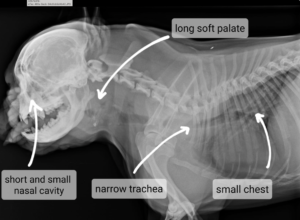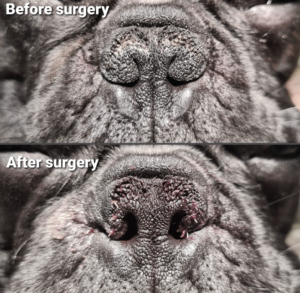
Here at The Pet Vet we are going to be looking at some of the complexities of owning a ‘flat-faced’ (brachycephalic) dog. There are several breeds that fall into this description including French bulldogs, English bulldogs, Boston terriers, pugs, Cavalier King Charles spaniels, shih tzus and boxers.
So, what does brachycephalic mean? The scientific word, used by vets to describe short-nosed or flat-faced dogs comes from the Greek words meaning ‘short’ and ‘head’. There are some key considerations when choosing to own such a breed of dog, many of which owners are completely unaware of when they make this important decision.
Breathing problems
One of the most common issues with flat-faced dogs is brachycephalic obstructive airway syndrome (BOAS). Due to the amount of tissue packed into a shorter nose, these breeds often suffer with narrow nostrils, narrow nasal passages and windpipe. Coupled with an overlong soft palate, these hinder the ability for the dog to breathe normally, reducing the amount of oxygen that can be taken with each breath.

Heat
As dogs cannot sweat and regulate their temperature through panting, these breeds also tend to struggle with heat, too. Dogs with a longer muzzle are much more able to cool themselves quickly, drawing in sufficient air over the large surface area of the tongue. However, those with shorter noses are unable to do this efficiently and can often overheat in hot weather. Sadly, overweight or sometimes older flat-faced dogs can die prematurely in hot weather conditions.
Heart problems
It stands to reason then that some flat-faced dogs, struggling to breathe efficiently, will also suffer with heart complications. The shortened airways and laboured breathing result in lower amounts of oxygen reaching the bloodstream. This, in turn, puts increased pressure on the heart to function effectively and many of these breeds become susceptible to secondary heart problems.
Education is everything. If we know what to look out for, we can help our dogs to avoid many of these complications and know how to manage their individual situation.
Symptoms to look out for in your flat-faced dog include:
- Noisy breathing
- Panting excessively, even at rest
- Snoring
- Unable to exercise properly, needing rest and regular breaks
- Struggling in hot weather
- Sneezing excessively
- Blue gums
- Collapse
Treatment
There are a number of options to help your dog, but before you reach the point where more invasive action is required, consider weight management, a gradual approach to building their fitness and sensible timings for walks in hot weather and additional measures to help them to keep cool.
Ultimately, for some dogs, surgery is the only long-term solution. During a surgical procedure, the vet will widen their nostrils and shorten their soft palate. They may also need the saccules from their windpipe removed. Surgery is not without risk and your vet will discuss what is best for your dog’s individual situation.

Owning a flat-faced dog
When choosing a pet of any kind, the vast majority of us are doing so out of pure love for that pet. We want to give them the best life and a healthy one.
However, is it a sad fact that many flat-faced breeds will have a lower quality of life simply due to their physical make up. Many will need veterinary intervention to help them along the way. Whilst these breeds are usually chosen due to their sociable temperament and gentle personalities, if you are seriously considering owning a flat-faced breed of dog, consider how you will manage their weight effectively, how you can sensibly build a fitness programme that will be accessible and helpful to them. And in warm weather, be aware of the limits in how they can manage their temperature and ensure you supplement those efforts to keep them safe.
If you decide this is the breed for you, always check rehoming organisations in the first instance. If you wish to seek out a puppy from a breeder, be sure the breeder has the pet’s best interest ay heart and is breeding for the right reasons. Ask to see the relevant health certificates for the breeding parents and speak to the parents’ vet to enquire about the health of those parents.
Being fully informed gives you the greatest opportunity to have a happy and healthy pet.
